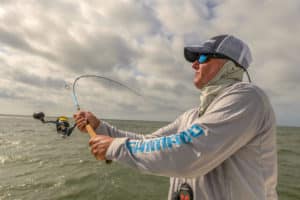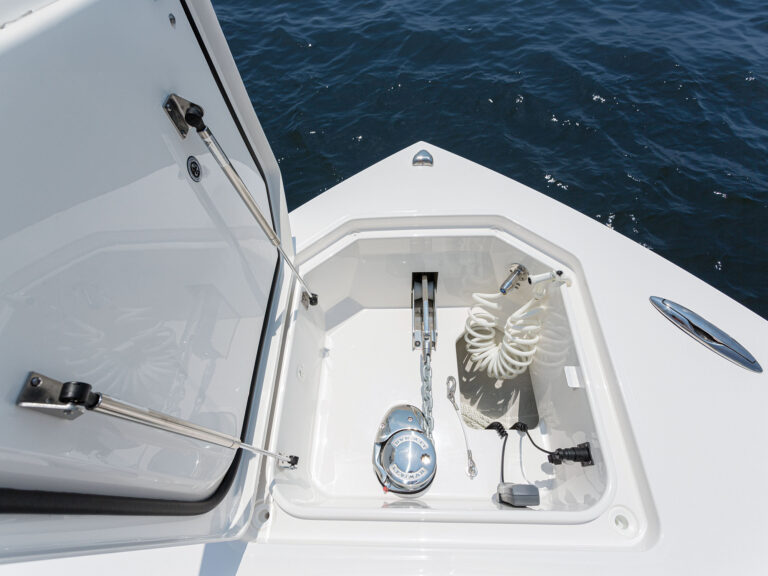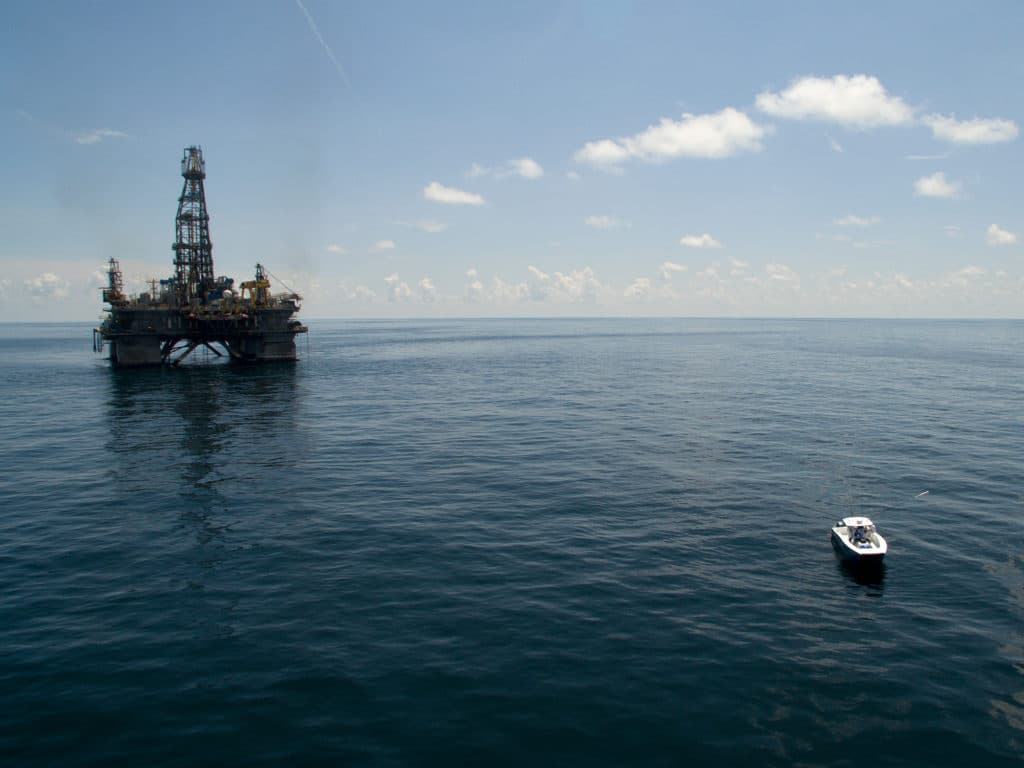
Brian Evans was straining to finish his up-and-down battle with a 45-pound yellowfin tuna when the blue marlin appeared.
Earlier that morning, we had hauled ass in Capt. Kevin Beach’s 37-foot Freeman, Pale Horse, to the Sevan Louisiana drilling rig (not pictured), almost 75 miles from the mouth of the Mississippi River. Brown, cloudy river water pushed out into the Gulf of Mexico, driving clean blue-green water and pelagics far offshore.
The tuna picked up the first blue runner, dropped back about 20 yards from Sevan Louisiana. Evans grabbed the rod and bumped the Shimano Talica 25 lever drag to strike, diverting his speeding tuna’s path toward the 2,200‑foot depths.
It was game on at the floaters.
Live-Baiting Billfish
“Marlin! Marlin at the boat!” yelled Beach, as he watched Evans’ tuna tiring near the surface. “Must have followed up your tuna!” Beach’s enthusiasm was intoxicating, alerting everyone to peer out from the catamaran to watch the 400-plus-pound blue marlin swipe at the hooked tuna.
Beach ran up to the coffin box to grab a fresh blackfin as bait, but deckhand Parker Rodrigue quickly called out and reminded Beach of a lively bonito (little tunny) waiting in a tuna tube. Beach danced back to the cockpit, grabbing a marlin setup loaded with 130-pound PowerPro topped with 100 yards of 80-pound Seaguar fluorocarbon and a 300-pound wind-on leader. He pitched his bait out to the marlin, just behind the triple Yamaha 300s, and hooked up almost immediately.
Angler Jonathan Zucker was ready for the task, outfitted with a fighting belt and back brace. He took the rod and held on as the fish dived deep, never once jumping at the surface. Rodrigue coached and applied cool rags to Zucker as he battled the behemoth billfish; Beach kept on the throttles, positioning the boat favorably. After 50 minutes of stress and anticipation in the shadow of the rig, Zucker reeled the marlin boatside, having fought the fish with 25 pounds of drag during most of the fight. A quick tag and revival, plus a couple of photos, ended with the marlin swimming away strongly.
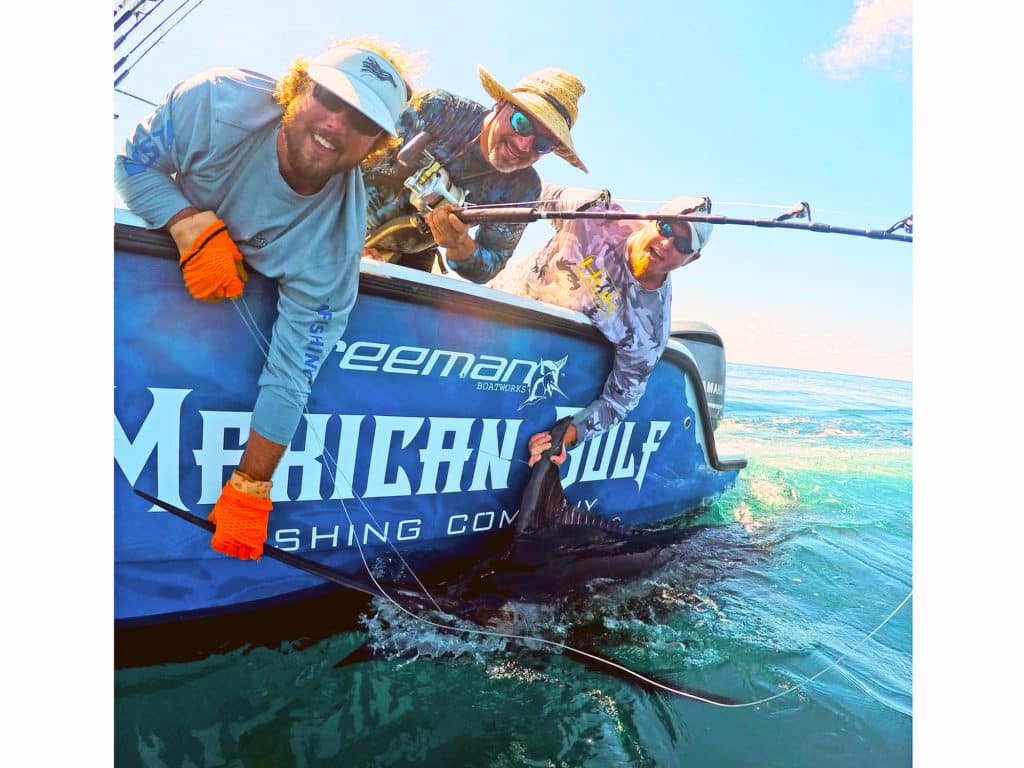
The entire crew, which included burgeoning angler JoAnne O’Bryant, an offshore-fishing novice, broke into hugs and high-fives. The captain of an oil-industry support ship near Sevan Louisiana called to us on the radio, excited to tell us he saw the entire hookup and battle. “Was that the man with a pointy nose?” he said. “We’ve seen him hanging around the rig for the last couple of days.”
Fishing floater rigs out of Gulf ports such as Venice, Louisiana, has a way of spoiling fishermen. Don’t expect blue marlin every trip — yellowfin and blackfin are much more common — but instead expect the unexpected.

Fixed or Floater
All FADs, or fish-attracting devices, are not the same. The entire Gulf has more than 3,000 fish-attracting devices in the form of oil and natural gas platforms, according to the United States Department of the Interior.
Different inland barges, platforms, rigs and other structures attract different fish species at different depths. In shallower waters, fixed platforms or towers are prevalent, ranging in depths from just a couple of feet to 1,000 feet. One common type of mobile rig, referred to as a “jackup,” can be found in waters from 90 to 450 feet.
“Once the continental shelf starts to drop out past 1,000 feet, we lose bottomfishing opportunities,” says Capt. Zach Lewis, of the Mexican Gulf Fishing Company (MGFC). “There are just a few rigs along the drop that cater to deep-dropping.”
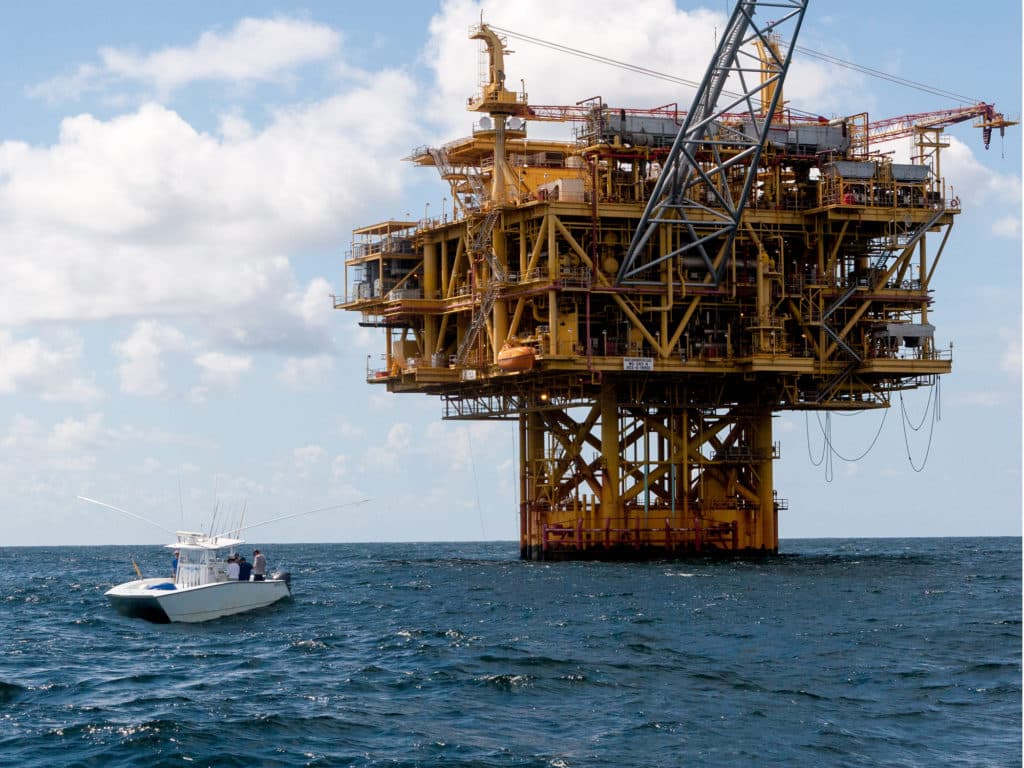
When anglers power out to the deep waters of the Mississippi Canyon, they’re liable to fish different types of floater rigs, including spar platforms, tension-leg oil platforms, floating production platforms, semisubmersibles or even drillships. But the type of floating rig is not nearly as important as the quality of the water surrounding it and the baitfish attracted to it — these key features attract species like tuna, wahoo, and blue and white marlin.
Yellowfin tuna are available year-round at the numerous platforms that dot Gulf waters. Wahoo topping 50 pounds hang along the continental shelf too, preferring blue-water drop-offs, weed lines, seamounts and oil rigs, with the best months from December to March. Blue and white marlin are available in the summer months, especially from May to July. In early fall, whites can school up, allowing for multiple hookups. The blues average 250 to 300 pounds, preferring deep waters that require runs of up to 100 miles. Beach mentioned that another blue marlin bite can occur from November to February if he can find 78-degree water temperatures. He uses big blue runners or bonito for bait.
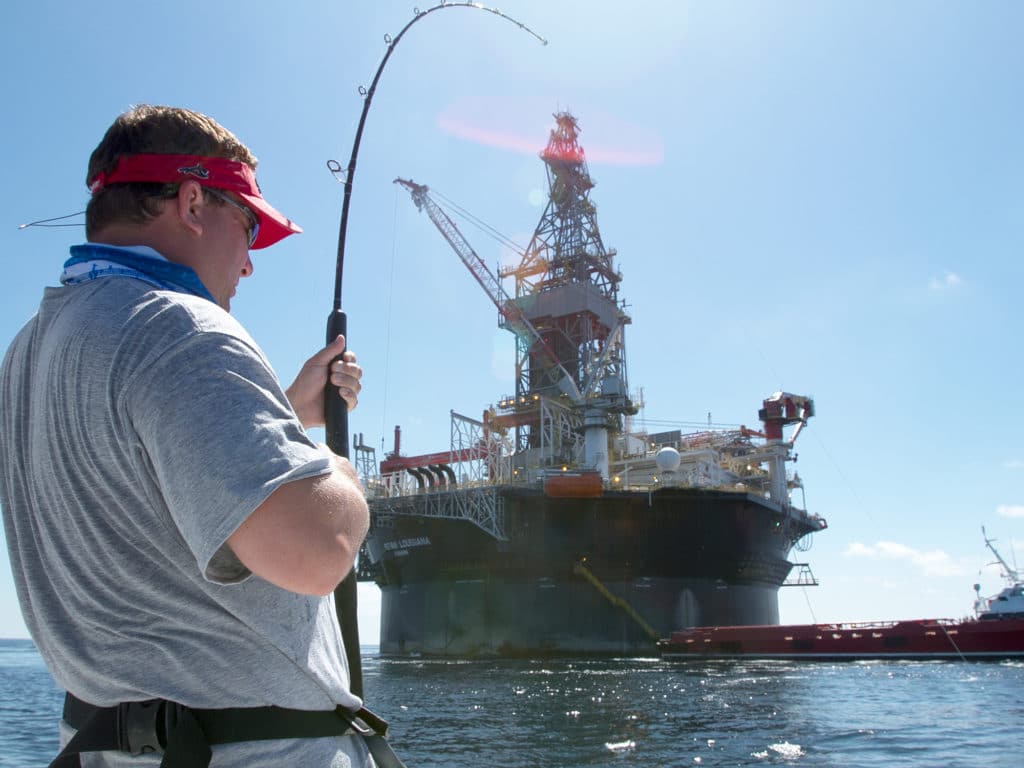

I fished out of Venice, Louisiana, in August 2015 in waters ranging from 1,500 to 2,800 feet. At that time of year, platforms holding yellowfin tuna included Delta House (floating production system, or FPS), Elf (mini tension-leg platform), Medusa (spar platform), Noble Amos (semisubmersible), Who Dat (floating production unit, or FPU) and Sevan Louisiana (semisubmersible). It’s unreasonable to list all the rigs that yield fish, because most can; fishermen must explore the rigs themselves or rely on local reports.
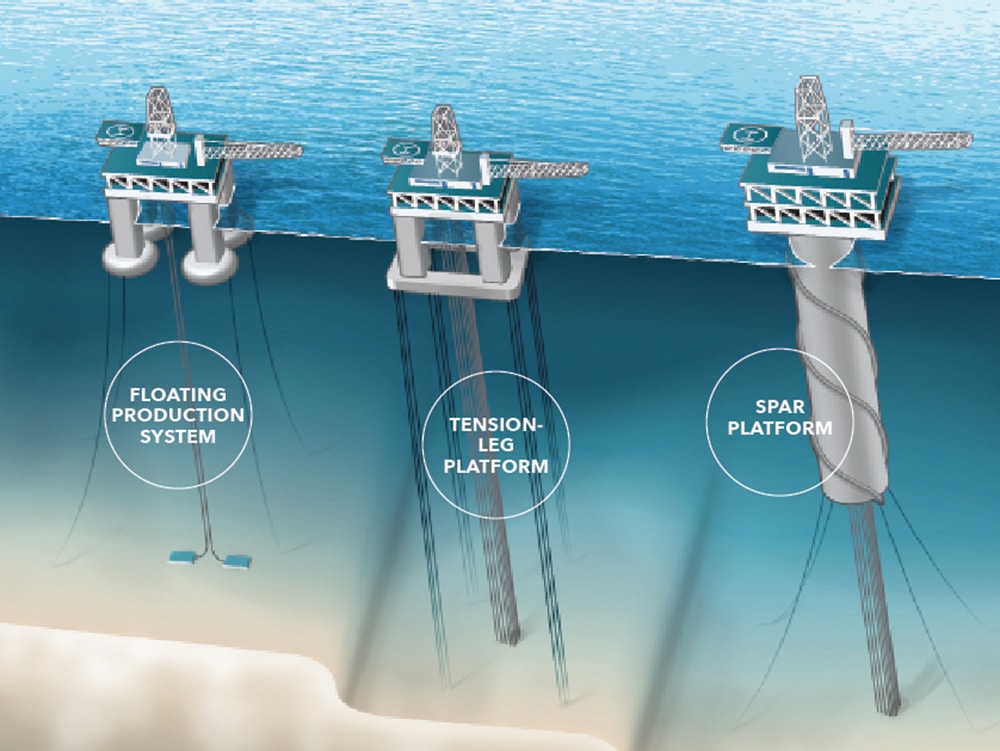

Location, Location, Location
The fall and winter months off Venice are recognized as the best months to fish offshore. Clean water pushes closer to shore, coupled with diminished discharge from the mighty Mississippi River. The largest wahoo and yellowfin each year are caught during this period.
“Fall and winter months also exhibit the most unpredictable, windy weather, limiting the number of days available to fish offshore,” says Lewis, who fishes out of a 39–foot Contender, Contagious. “Running all the way out to floater rigs isn’t really necessary.”
Other seasons in the year are completely different. Spring and even summer rains keep Mississippi water levels high, dumping brown fresh water far out into the Gulf. The cloudy waters take over nearshore humps and rigs that might produce pelagics in the winter, forcing captains to run to clear green or blue waters. The rigs themselves are ideal surface structure, attracting bait and sport fish.

“Wind out of the southeast is much more favorable than west winds,” says Capt. Jordan Ellis, who runs a 40-foot Freeman, ShockWave, out of Venice Marina. “West winds help push dirty fresh water out into the Gulf and blue water farther offshore.”
After arriving at a floater, check for surface action. Yellowfin and blackfin tuna at times launch from the water, attacking baits at the surface. Have a spinning rod rigged with a disturbance popper like the Shimano Orca. When a tuna attacks while sight-fishing, make sure to feel the weight of the fish first, before setting the hook. Otherwise, you’ll pull the bait away too quickly.
Mixed in with surface yellowfin are often blackfin and little tunny. The bullet bonito are top live bait for marlin, so Beach likes to keep a couple in tuna tubes on his boat. Much closer to the rigs are opportunities to sabiki baitfish such as blue runners, threadfin herring and speedos, though the captains of the MGFC tend to stop at nearshore wrecks first, to catch bait as insurance, before heading out to the floating rigs.
If other fishing boats are at the rig, they’ll be clustered on the up-current side. “The majority of fish are caught there,” says Ellis. “Check for subcurrents too; tuna can orient to different currents in deeper water than what’s showing at the surface.”

Ellis frequently watches his electronics, skipping all the noise at the water’s surface to check for large blips at 100 to 200 feet. “That’s got to be a 500-pound fish,” he said, pointing to an unusually large mark on his Simrad screen. “It might even be a marlin.” Almost simultaneously, an angler fighting a yellowfin tuna had his fish attacked 200 feet down. After a couple of seconds of heavy pressure, the line went slack.
“I guess that answers the mystery,” said Ellis, as he reached out to gaff the head of an estimated 60-pound tuna. “It might have been a tiger shark,” he guessed, counting the distinct teeth marks on the tuna. Not many sharks can turn a 60-pound tuna into a 10-pounder in one clean bite.
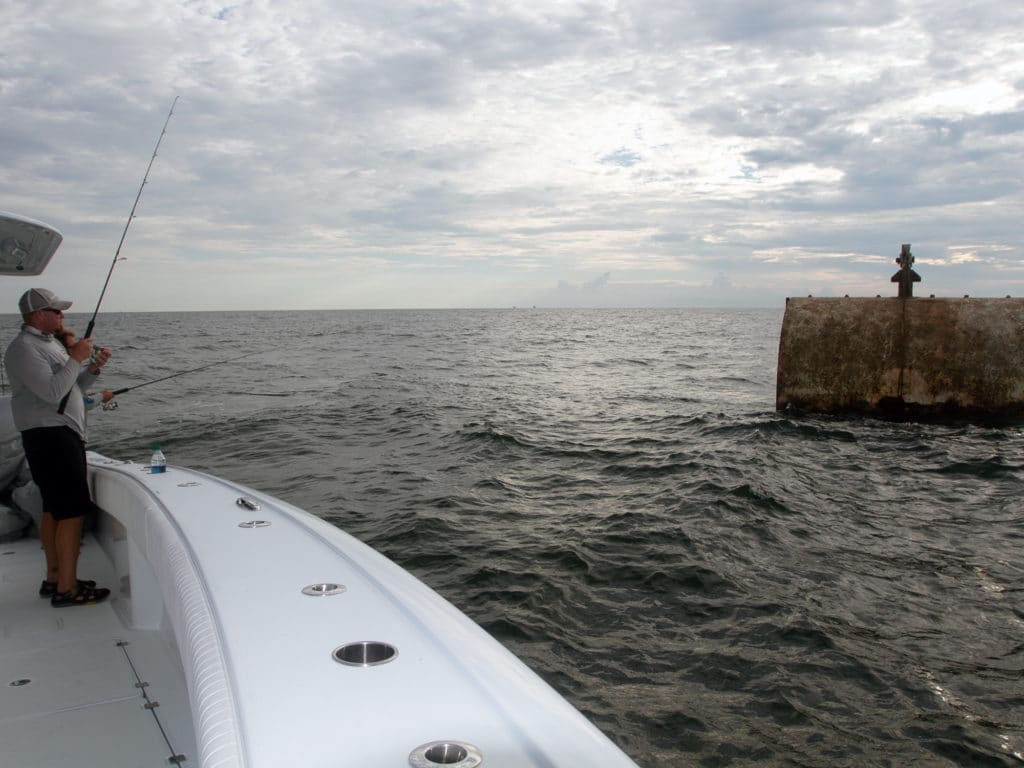
Prepare for the Bite
Each morning before heading out to the floaters, MGFC captains stopped at nearshore rigs to catch baits using sabiki rigs. Sometimes the structure was the actual rig; other times it was giant anchor buoys near platforms on which barges moor. Beach looked for blue runners that measured from his thumb to the tip of his index finger, with his hand held as if shooting a gun. Small hardtails (blue runners) are favored over larger ones.
Ellis really drove that point home, heading out to open water along tidelines to catch jumbo threadfin herring in schools. “The time of year truly dictates what the tuna are eating,” he says. “There are times when you can mark tuna deep at the rigs, but they won’t touch a bait.” The day I fished with Ellis, most of our fish were hooked on herring, while the blue runners (hardtails) were not as successful.
Ellis believes it’s vital to utilize the seasonal bait available in the area he expects to fish. Threadfin herring are common from July to September. From October to November, large mullet invade area waters.
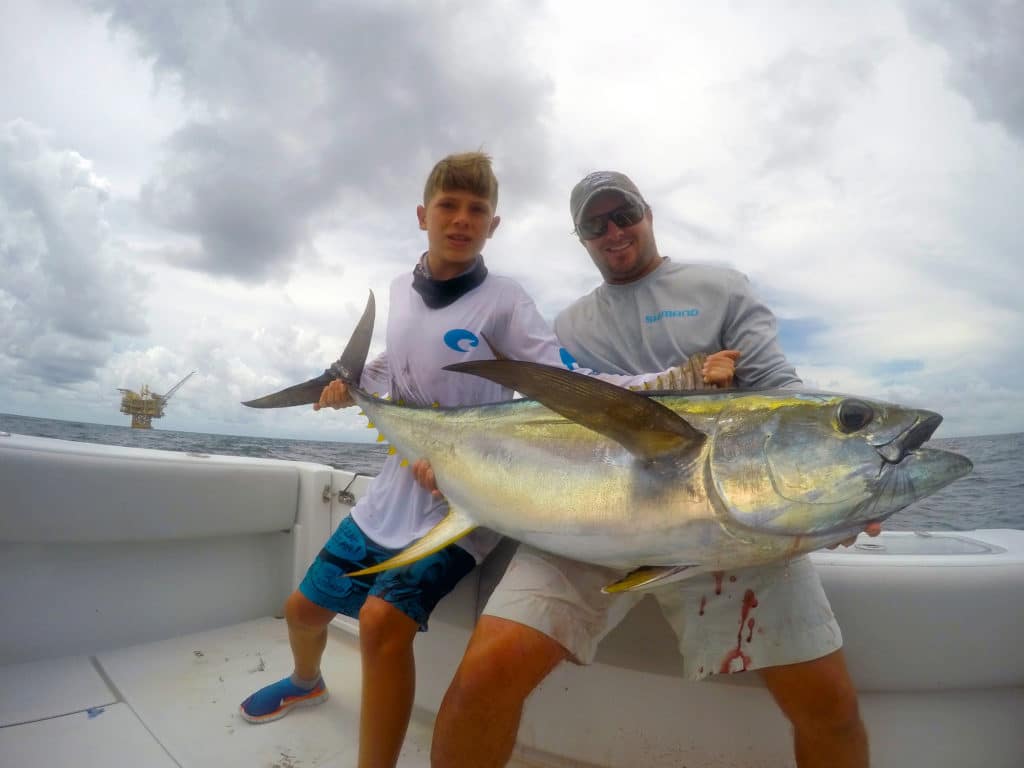
“Those big tuna that we catch in the fall feed on the large mullet,” he says. “They’ll head closer to shore to follow the mullet and get sidetracked at the shrimp boats where anglers target them. I’ve caught yellowfin in 60 feet of water behind shrimp boats.”
Menhaden are prime bait from December to April, with hardtails available most of the year, except for the cold months when only the largest specimens hang around.
For tuna tackle, Lewis uses Shimano Talica 25s spooled with 80-pound braid, connected to 100 yards of 60- to 80-pound Seaguar fluorocarbon, terminating with a snelled Mustad 6/0 3X circle hook. “The leader starts at 100 yards, but it shortens quickly over time as we catch fish, cut off frays and rerig hooks,” he says. Lewis deploys a single bait on each outrigger, with a third bait fished deeper using a weight and rubber band.
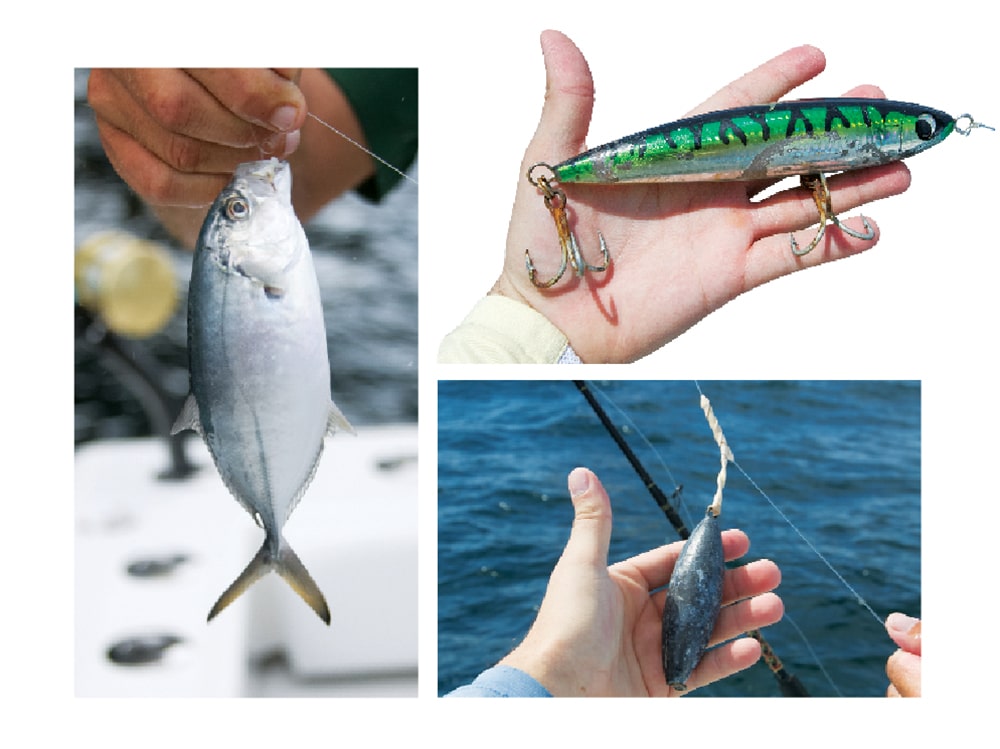
Paired with the Shimano setups is another vital tool — the fighting belt. Don’t let your friends call you a wimp when you opt for a belt; this piece of gear is critical for hard-fighting tuna.
I’m no tuna pro, but I realized quickly that I could land tuna up to 60 to 70 pounds using a Cush-it soft cover over the gimbal to protect my body. Anything larger, and I went straight to an AFTCO fighting belt. The belt handles the setup and fight better, and allows anglers to apply more pressure. For a prolonged fight with a heavier fish, add a back harness that connects to the reel mounts. The harness takes much of the sting out of your lower back. No matter the angler’s fitness, pumping and reeling a big tuna will tire your body, and these tools can help shorten the fight time.
Modest Mouse singer Isaac Brock wasn’t alluding to offshore fishing when he penned the song “Float On,” but many offshore captains in the northern Gulf take that motto seriously each day when they head offshore.
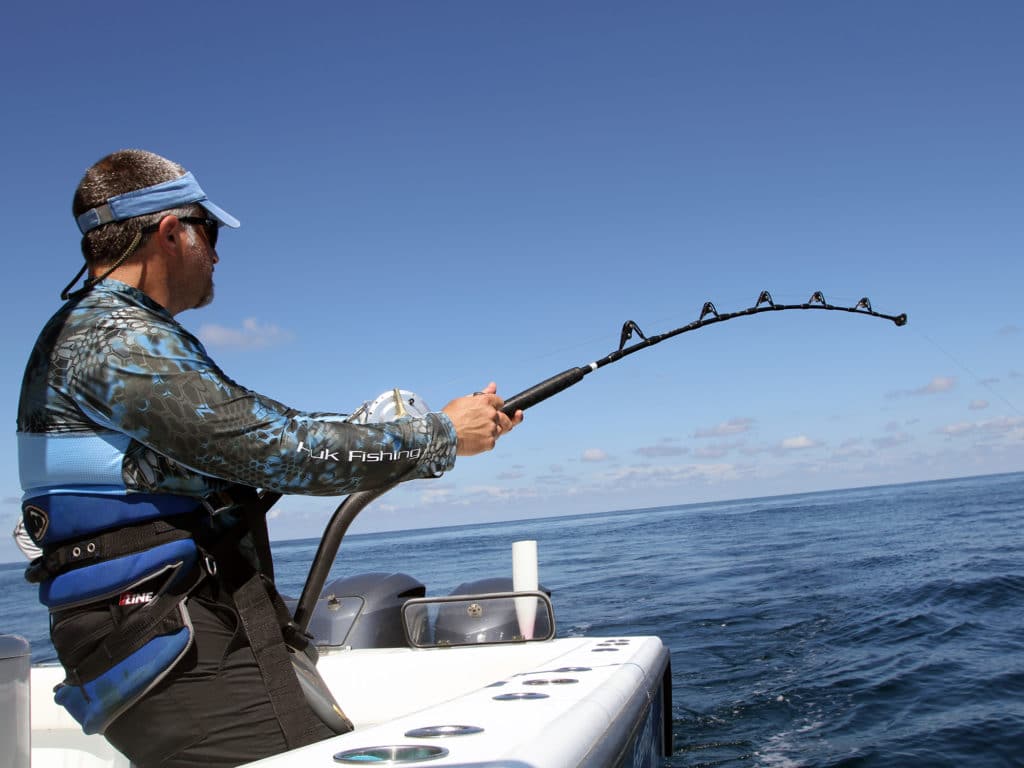
Sideshows: Other Fish Off Venice, Louisiana
Besides the chance to fish the floaters for pelagics, the waters off Venice also offer plenty of “sideshow” action. Riding back in from a slow offshore day, or when a specific season is open, such as red snapper, anglers should head for inshore rigs from 100 to 300 feet.
Fishing with Capt. Kevin Beach at one yellow tower in about 270 feet, I watched anglers catch amberjacks on four straight drops, along with a healthy red snapper. One amberjack was likely the largest I’ve seen in person, requiring father-and-son team Frank and Hoss Skapura to both hold the fish. Nearby, a kingfish skyrocketed on hapless baitfish. It was simple fishing, using bottomfishing gear and the blue runners left over from offshore.

Besides rigs, shrimp boats are also available year-round. Depending on the month, the trawler boats will be in different locations, often attracting trailing sport fish. Fishing with Beach, we pulled up bow-to-stern behind an Alabama boat actively hauling its nets. Since the shrimp nets sit low in the water, our boat did not affect the other boat’s fishing.
Beach and his mate Parker started chumming chunks of blue runner and false albacore to pull the fish away from the trawler and toward our boat. With the tunas swirling around our cat, we were able to catch blackfin and small yellowfin using live baits and speed jigs. These same shrimp boats attract yellowfin tuna weighing more than 100 pounds during the fall.
Off the Water
Home port for me while fishing the floating rigs was Venice Marina in Venice, Louisiana. The town shows little development, with much of the population transient and reliant on the fishing and oil industries. But at Venice Marina you’ll find a thriving mix of captains heading offshore, marsh guides targeting redfish and speckled trout, and commercial fishing boats. Crawgators restaurant sits on the second story, allowing patrons to watch all the offshore boats return to the docks around 5 p.m.
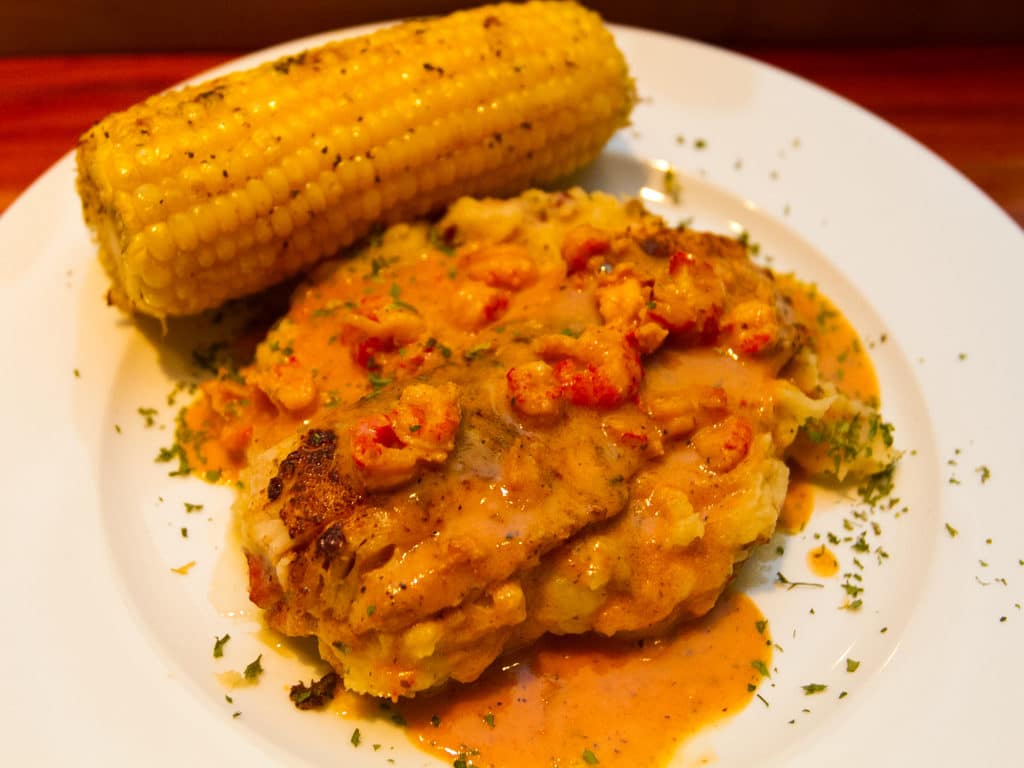
I stayed at the SWC Sportsmans Lodge, a two-story floating resort that features seven different staterooms with widescreen TVs. A giant lounge is located downstairs near the full kitchen and bar, where anglers meet after the day’s fishing to catch up or watch a golf tournament. Chef and angler Richard Young, along with crewmembers such as Jeremy McHugh, provide everything for guests, including delicious meals of fresh seafood such as tuna, redfish, seatrout and shrimp.
Upstairs is a second great room where one can watch TV or play cards. And since the back porch is directly on the water, each morning your captain is able to pick you up at your doorstep. Venice is a hardcore fishing town, and the Sportsmans Lodge provides serious fishermen with a memorable and hospitable place to stay and play.

